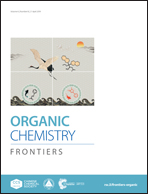Mechanistic studies for dirhodium-catalyzed chemoselective oxidative amination of alkynyl-tethered sulfamates†
Abstract
The mechanisms for Rh-catalyzed chemoselective oxidative amination reactions of alkynyl tethered sulfamates were systematically investigated by DFT calculations. Calculation results indicate that the reaction of nitrene with the alkyne moiety undergoes a singlet pathway involving an asynchronous concerted cyclization as the key step. Formation of the α-iminometal carbene intermediate is through cycloaddition, Rh-catalyst migration, and electrophlic attacks to alkene steps. The ring expansion reaction for the substrate containing a cyclopropane moiety is not only kinetically favored but also thermodynamically stable because of the high electron-density on the C–C bond. Alkoxyl group migration for cyclobutane compounds without such a character is just a kinetically favored process. For a substrate bearing a phenyl group, the reaction goes through the thermodynamically stable 6-exo α-iminometal carbene intermediate to give the product because the interaction of H2O with the N atom decreases the energy barrier of the termination of 6-exo α-iminometal. For substrates bearing a benzyl group, a novel non-carbene mechanism is proposed, which can account for the experimental results very well.



 Please wait while we load your content...
Please wait while we load your content...